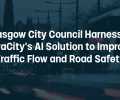After three years of developing our AI traffic signals optimisation system, we want to take a look back at our journey so far, and outline what the future holds for VivaCity Smart Junctions.
We have hit major milestones since partnering with Transport for Greater Manchester (TfGM) and Immense Simulations for an Innovate UK co-funded project to build and trial a solution which uses AI to optimise traffic signals networks. Results from real-world trials have proven that AI can be used to reduce journey times through a junction by an average of 23%. We are constantly scaling up our practices, and expect to keep quantifying our product into the future.
Our data-led sensors have helped local transport authorities overcome some key issues facing local transport infrastructure systems. With air quality, congestion and active travel now top priority in local communities, VivaCity has worked alongside councils and local stakeholders to deliver reliable and efficient transport routes.
Collectively, our sensors, traffic simulation model, and optimisation algorithm have been key to us reaching major milestones, including:
Simultaneous Control of Five Junctions
After independently controlling three neighbouring junctions last year, we scaled the system to control a whole key corridor on the main orbital route on the Manchester Salford border.
Continuous, unsupervised control
We improved the robustness of the system to allow us to leave the control pipeline running for long periods of time without the need for constant, human monitoring. In order to achieve this, we developed a set of alerts to notify the users (VivaCity internal team initially) about any system or performance issues. We tuned the alerting parameters to adjust the agent configuration and the alert thresholds and build confidence in the completeness of the alerts.
Control Algorithm Improvements
Over the past year, we have carried out a detailed research programme to improve the operation of Reinforcement Learning for signal control, building on our work in 2020. Combining the latest academic research with innovations of our own, we have seen substantial improvements in underlying performance.
We have streamlined our initial site scoping process. Our team can now accurately determine the number of sensors required in a single site visit, and find the ideal balance between sensor coverage for optimal performance and cost. Increased automation means we have reduced the time required to configure, calibrate and validate a simulation by more than half following sensor installation. To effectively monitor, improve and respond to issues, we have developed monitoring and alerting systems that allow us to react to traffic conditions and Infrastructure performance as well as Algorithm performance and altering.
As well as growing the deployment of our AI control system to junctions within Greater Manchester, we have partnered with Cambridgeshire County Council and Peterborough City Council to roll out the system to five more junctions across the UK.
Looking forward
VivaCity is investing heavily into further research in this field to support our anonymous data insights. In particular, we have a strong emphasis on multi-modal control, and optimisation for the wide variety of scenarios that authorities may implement in the future. We will continue using delay as the main metric for performance evaluation of vehicle congestion reduction, while adding stopped time for pedestrians and cyclists as a second measure later this year. Alongside our won assessment, we will endeavour to have an independent party evaluate our performance as well.
Learn more about how our Smart Junctions solution is revolutionising traffic signal control systems and outdated legacy equipment.
Like our content? Sign up to our newsletter and receive the latest updates in your inbox.
Sign-Up









